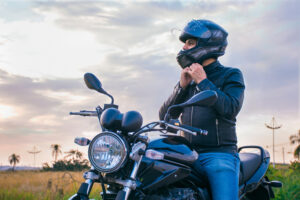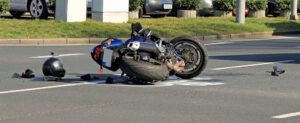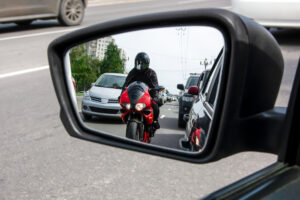Riding a motorcycle through New Orleans offers an unparalleled sense of freedom, with the vibrant cityscape on one side and the sprawling Mississippi River on the other. However, navigating the streets of our city can be challenging due to sudden summer downpours and crowded events like Mardi Gras. This poses specific risks even for experienced riders.
May is Motorcycle Safety Awareness Month. It's a good time to focus on important safety tips for motorcyclists in the Crescent City and beyond.
At Huber Thomas Law, our commitment to the New Orleans community goes beyond legal representation. Our goal is to ensure that your travels in our city are both exciting and safe. You can navigate through the diverse landscape with confidence. We have gathered important motorcycle safety tips based on our knowledge and experience in New Orleans.

By sharing this knowledge, we aim to cultivate safer roadways for everyone—motorcyclists, drivers, and pedestrians alike. Join us in making every motorcycle ride safe and joyful in our city. Let's work together to ensure the safety and happiness of all riders. If you require help from motorcycle accident attorneys, contact us for a free legal consultation.
Evolving Motorcycle Safety: Navigating the Road Ahead
The joy of riding a motorcycle on open roads during the sun-drenched summer months is unmatched. With more flexible schedules and the allure of long vacations, it's a season many riders eagerly anticipate. However, this increased activity also brings a heightened risk.
Motorcycles account for only 3% of registered vehicles and 0.6% of vehicle miles traveled in the US. However, riders of motorcycles face a higher risk on the road.
In 2021, motorcyclists accounted for 14% of all traffic fatalities. They also made up 17% of deaths of people in vehicles. Additionally, motorcyclists suffered 3% of all injuries to people in vehicles.
Recent statistics reveal a concerning trend: fatalities among motorcycle riders and passengers rose by 8% from 2020 to 2021. This uptick in deaths is alarming, with the total number of motorcycle fatalities reaching 5,932.
It's important to note that the number of deaths per 100 million miles driven went down by 2% during that time. Over the past decade, deaths have surged by 19%, underlining a persistent challenge in motorcycle safety.
The dynamics of motorcycle use have seen significant shifts from 2007 to 2021. While the number of registered motorcycles has increased by 38%, the total miles driven have decreased by 8%.
The decrease in miles traveled is causing the fatality rate per 100 million vehicle miles traveled to increase. This shows a complex relationship between how often people travel and the safety of their trips.
In 2021, a closer look at the circumstances surrounding motorcycle fatalities highlights several key factors:
- The majority (67%) of motorcyclist fatalities occurred on urban roads.
- 83% of accidents occurred in good weather, challenging the belief that bad weather is a main risk factor.
- Half of these fatalities occurred during nighttime hours, stressing the importance of visibility and caution during these times.
- Over half (53%) involved two-vehicle collisions, pointing to the need for increased awareness among all motorists.
- It is interesting to note that 59% of the riders who died were wearing helmets. This shows that helmets are important for safety, but there are other factors that also contribute to fatal outcomes.
- Encouragingly, 72% of motorcycle operators involved in fatal crashes were not impaired by alcohol, indicating a high level of responsibility among the majority of riders.
In 2021, injuries increased by 5% among motorcyclists. However, the injury rate per mile traveled decreased by 4%. This indicates a slight improvement in safety.
These evolving statistics serve as a critical reminder of the ongoing need for awareness, education, and proactive safety measures among motorcyclists and the driving public alike. They underscore the importance of helmet use, sober riding, adherence to traffic laws, and the development of skills that can mitigate risks. As we navigate the roads, it's imperative to foster an environment of mutual respect and caution, ensuring that the freedom of riding can be safely enjoyed by all.
1. Follow Louisiana Motorcycle Laws
Motorcycle laws in the U.S. vary by state. Many states require helmets for all riders, but some only for those under a certain age. Other states, like Illinois and Iowa, have no helmet requirements at all.
We're thankful that Louisiana is a state that requires helmets for all motorcyclists and passengers. Even if you live in a state without this law, you should absolutely wear a DOT-compliant helmet as they're the best way to protect yourself from a traumatic head injury or death. Between 2022 and 2017, helmets saved more than 25,000 lives.
Other Louisiana motorcycle laws stipulate that you must:
- Complete a road rules and skills test to receive a motorcycle endorsement
- Make sure to wear the right eye protection when driving, like goggles or safety glasses. If you have a proper windshield or full helmet, you may not need to wear them
- Never overtake or pass other vehicles in the same lane (a practice known as lane-splitting)
- Keep both hands on your handlebars while driving
Further, you can only carry passengers if your motorcycle was made for multiple people. Children must be five years or older, in an appropriate seat.
2. Be Alert to the Most Common Causes of Crashes
Motorcycle crashes most commonly occur when:
- Another vehicle turns left in front of you
- You hit an unsafe or slippery patch of road
- Another vehicle changes lanes into you
- Someone opens a car door into your oncoming bike
- You were traveling too fast
- Another driver stops suddenly, or rear-ends you
- Anyone is driving under the influence of drugs or alcohol
RideApart provides helpful information and videos on how to prevent and handle the most common motorcycle accidents. We recommend reading and watching these videos in full, whether you're a new or experienced driver.

3. Never Drive Under the Influence
We're noting this twice because it's that important.
At night, 29% of motorcyclist fatalities happen when the motorcyclist had a BAC above the legal limit of 0.08%. Never drink and drive. Make it a rule to avoid driving if you've had even one drink.
Likewise, avoid driving after any use of prescription sedatives, pain medications, or other drugs. For example, while marijuana may be legal in some states, it can still lead to a change in your driving skills.
4. Know Your Risks
Before you ever step up to your bike, be aware of and proactive about your specific risks.
If you're an inexperienced driver, plan to ride in slower, safer conditions until you build your skills. If you are on a newer bike, practice riding off-road and in safer conditions until you build confidence.
Age also plays a role in motorcycle accidents. Those 50 years and older made up 35% of all motorcycle fatalities in 2021. The reasons for this are many.
Often, older drivers are "re-entry riders." They rode when they were younger and assume that they still know how to handle a bike. With more traffic, more powerful bikes, and diminished physical skills, this simply isn't the case.
If you're an older adult who hasn't ridden in a while, it pays to take a safety class to refresh your skills. Follow the other safety tips too, like getting used to your bike and practicing in safer areas before hitting the open road.
Finally, know that riding with a passenger takes much more skill. You can learn how to ride safely with a passenger here.
5. Wear Appropriate Safety Gear
We already discussed how DOT-compliant helmets can save lives. These helmets provide appropriate shock-absorption and peripheral vision capabilities. Look for a DOT sticker on the inside or outside of your helmet to ensure it meets safety standards. You can learn more about choosing a helmet here.
To protect yourself in the case of an accident, you should also wear:
- Clothing that fully covers your arms and legs in a thick material, like leather
- Boots or shoes that cover up to your ankles or higher
- Gloves for a better grip and to protect your hands
- Eye protection, such as a full helmet or goggles
- Reflective materials for better visibility
6. Do a Safety Check Before Each Ride
You've received your motorcycle endorsement, practiced in a secure area, and found the right safety gear. Even so, you should still do a quick safety check before each ride. At the very least check:
- The weather to ensure there won't be any slippery or unsafe conditions
- Your tire pressure
- Your bike's brakes, headlights, and signal indicators
- For any signs of oil or gas leaks
- That any cargo is properly secured and balanced
- That your protective gear is in good shape and worn correctly
7. Practice Active Awareness During Every Ride
Finally, if you drive a motorcycle, always ride responsibly and as actively aware as possible. This means:
- Watching ahead for any potholes, gravel, or puddles
- Proceeding cautiously at intersections, where most accidents take place
- Keeping your headlights on at all times to increase your visibility
- Leaving plenty of braking distance between yourself and other vehicles
- Using extra caution in heavy traffic or inclement weather
Not sure if you're aware of the best ways to protect yourself out there? We highly recommend taking a safety class. Louisiana State Police provide different motorcycle training programs, including basic rider courses and advanced lessons. There are a variety of other high-quality safety programs as well.
8. Practice Motorcycle Awareness on the Road
Motorcycle Safety Awareness Month is about reducing accidents and raising awareness about motorcycles with all drivers. Even if you don't drive a motorcycle, you can do your part to help all people on the road arrive at their destination safely.
Here's how:
- Practice caution when approaching a left turn, ensuring you use your turn signal and the road is clear of motorcyclists or allowing them to pass before turning
- Become aware of motorcycle turning and braking patterns
- Give motorcyclists the same (or more) space as you do other vehicles, allowing them a full lane width
- Yield to motorcyclists and give them plenty of space—even the smallest nudge can lead to a crash
- Check your mirrors and blind spots for motorcyclists before changing lanes or making turns
- Avoiding any and all distractions while driving, such as texting, eating, or playing with your car radio

Get Help from Motorcycle Accident Lawyers After a Motorcycle Accident
Even if you practice all of these safety guidelines, you could still be in an accident. Unfortunately, an earlier report notes that in two-thirds of passenger car and motorcycle collisions, the car violated the motorcyclist's right-of-way.
If the worst happens, there is help.
At Huber Thomas Law, we're dedicated to helping victims recover after an accident. We’re tireless advocates for our clients, helping you secure the compensation you need to cover any long-term costs after an accident. We also help you make sense of the insurance claims process. You can learn more about our approach to motorcycle accidents here.
If you've recently been in a motorcycle accident, contact us today for a free consultation. We can walk you through your legal options.
